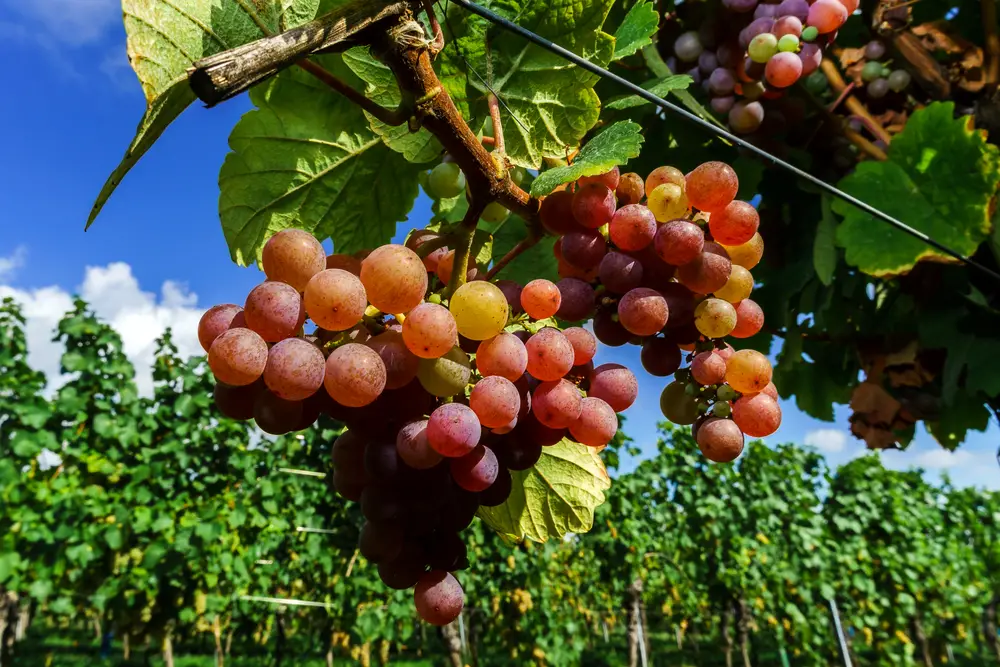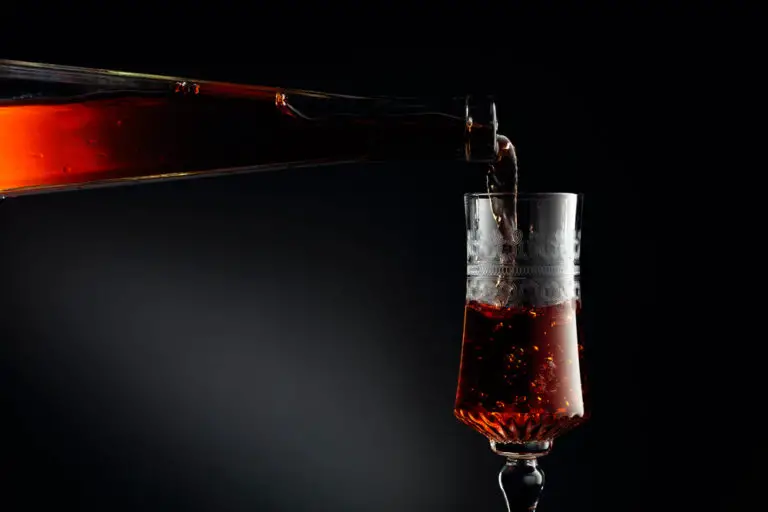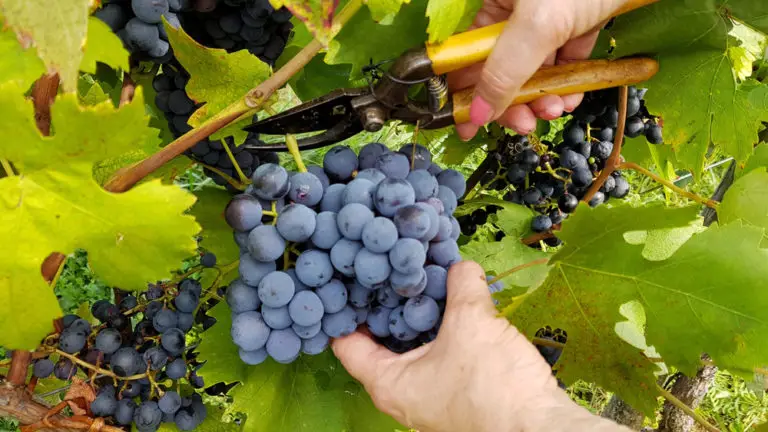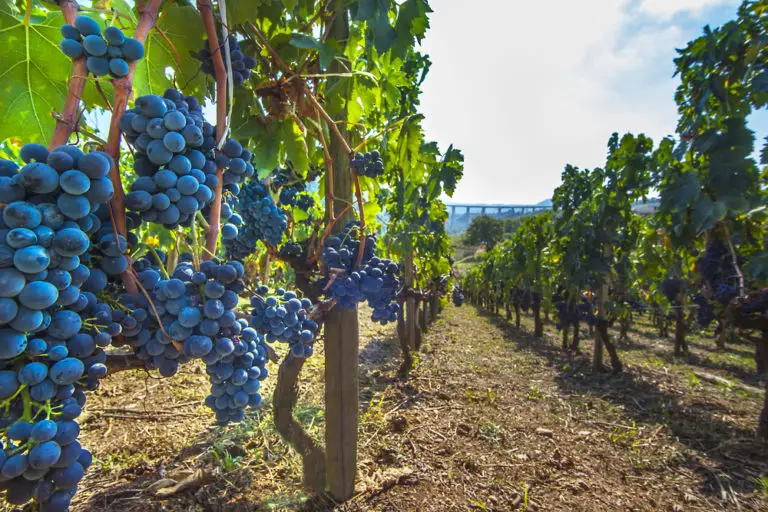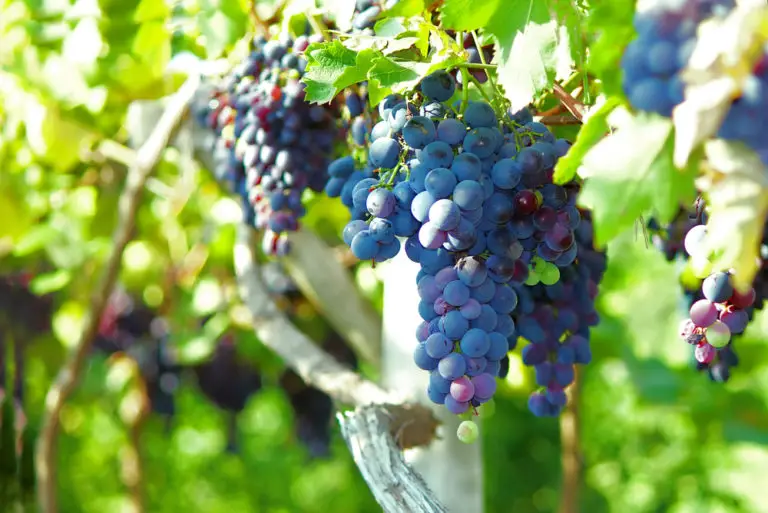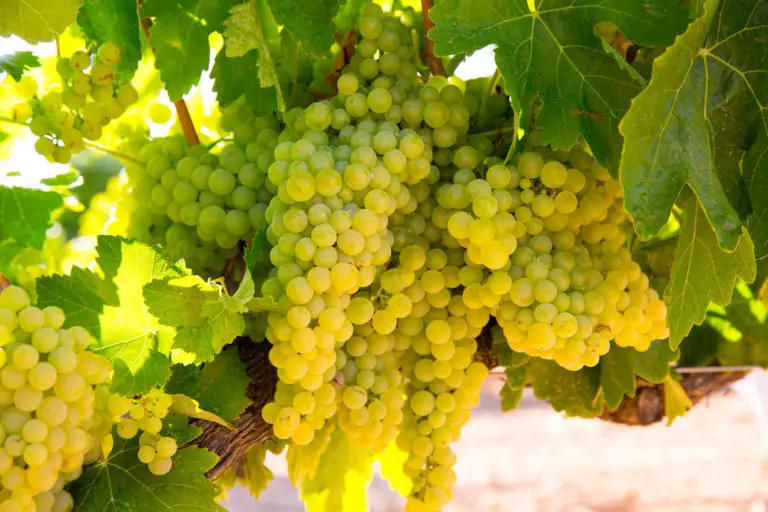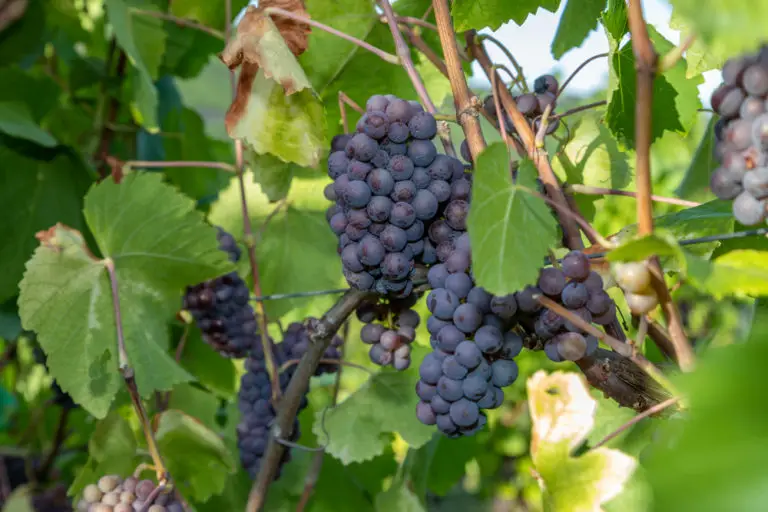Gewürztraminer: The Beginners Guide (2024)
Gewürztraminer is an old German grape variety with slightly reddish berries that makes high demands on location and soil. Experienced winemakers turn the grape variety into very fine wines. It is a classic and has made up around 1% of the area under vines in Germany for decades, no more and no less. This wine is aromatic and has a tart, spicy fruit taste.
- What is Gewürztraminer?
- Known Regions for Gewürztraminer
- Popular Blends of Gewürztraminer
- How to Enjoy Gewürztraminer?
- How is Gewürztraminer Made?
- History of Gewürztraminer
- Alternatives for Gewürztraminer
What is Gewürztraminer?
The German white wine gewürztraminer is also called Roter Traminer because of its unexpectedly reddish grapes. It is said to have been widespread on the wine route in the south of South Tyrol as early as the 11th century.
Somewhat forgotten in the meantime, today, it is again one of the most popular drops in white in South Tyrol and throughout Italy. It is not for nothing that the DOC Gewürztraminer keeps winning international awards. Gewürztraminer pronunciation is guh-VOORTS-truh-MEE-nur.
Gewürztraminer wine often retains a subtle residual sweetness, as not all of the sugar can be fermented. The wine also often sparkles a little. It is stronger, and fuller in body and alcohol than other wines. Under favorable conditions, it develops into a great wine with age. Sparkling wines and fruit brandies from Gewürztraminer are rare specialties. It is a spicy and aromatic wine with low acidity and has high pH.
Gewürztraminer vs. Riesling vs. Gruner Veltliner
Gewürztraminer and Riesling are both aromatic white wines that share similar roots. But there are some differences between the two that make them altogether separate experiences.
Riesling has higher acidity in comparison with Gewürztraminer. When it comes to price comparison between the two, resiling is more budget-friendly, and the other tends to be slightly less pricey per bottle. Similarly, Gewürztraminer has a high alcohol content and is much more aromatic, while riesling has high acidity. Gewürztraminer is also high in pH, contrary to riesling.
When it comes to comparing between Gewürztraminer and Grüner Veltliner, Gewürztraminer can be dry, semi-dry, or sweet, whereas Grüner Veltliner is produced in dry style with a hint of sweetness. The acidity of Grüner Veltliner is very high making it impossible for many people to taste, while Gewürztraminer has low acidity and high natural sugar levels.
Gewürztraminer Characteristics
This wine is typically spicy and very aromatic; it varies greatly due to its aroma, sweetness, and dryness. Along with these characteristics, it also differs in taste, taste, and color. In contrast to other white wines, the Gewürztraminer characteristic makes it a strong German wine. The characteristics of both the grapes and the wine also depend on the region in which the grapes are grown.
The thin skin and the unique taste of these grapes make this wine extremely sweet and rich in alcohol. It is also low in acidity and high in pH. As a result, it sometimes becomes problematic to combine this wine with other types of wine.
White wine Gewurztraminer often retains a subtle residual sweetness, as not all of the sugar can be fermented. The wine also often sparkles a little. It is stronger and fuller in body and alcohol than other wines. Under favorable conditions, it develops into a great wine with age. Sparkling wines and fruit brandies from Gewürztraminer are rare specialties.
Gewürztraminer Taste Profile
The Gewürztraminer has a very distinctive aroma – which the wine lover may or may not like. Not everyone likes the Gewürztraminer flavor and the distinctive smell, while others swear by these characteristics of the Gewürztraminer. If you want to get to know the Gewurztraminer sweetness, you should therefore start with a dry or semi-dry variety and then slowly feel your way to the heavier varieties.
Its aromatic range of aromas is reminiscent of roses and ripe fruits, lychee, passion fruit, passion fruit, maracuja, bitter orange, honey, marzipan, clove, acacia blossom, and nutmeg – depending on the soil and climate. Therefore, this German white wine is a variety for lovers of aromatic wines.
This grape ripens early and has small yields. Astonishingly, even the dry, clear wine with mild acidity can exude such a fruity, spicy fragrance. The spicy taste remains on the tongue for minutes. Its color is bright straw yellow and often shows golden yellow reflections. Together, this makes this wine a pleasure of its own.
Gewürztraminer Ageability
Wines are the result of alcoholic fermentation of the grape must. It is when fermentation ends that the aging of wine begins. However, we winemakers prefer to divide wine aging into two phases.
The first is called the wine stage. It is the most oxidative phase, which takes place before bottling, and which can happen in oak barrels or simply in a deposit, whether stainless steel or cement.
The second stage is aging, which takes place when the wine is already in the bottle. It is aging in a reducing environment, that is, in an environment where oxygen is scarce. And this type of aging is what I write about today.
Gewürztraminer, like most white wines, is meant to be best enjoyed young. A more concentrated wine will age from five to seven years. For instance, a Gewurztraminer with a Grand Cru appellation can age up to 10 years.
Notable Regions for Gewürztraminer
Gewürztraminer is a demanding grape variety when it comes to soil and climate. Although the vine is vigorous, it abhors calcareous soils and is susceptible to disease.
Gewürztraminer vineyard managers often keep a close eye on vines – it sprouts early, ripes erratically, and is susceptible to frost. In hot climates, the grape loses its natural sweetness, and there is not enough acidity to balance the high sugar level. Here is some notable Gewürztraminer region:
France
The Alsace region is the world’s largest Gewürztraminer producer and produces several exceptional sweet and less sweet wines. Styles range from very dry home style (Trimbach) to very sweet. You’ll also find late-harvest Gewürz, labeled Vendange Tardive and Sélection de Grains Nobles (using grapes affected by noble rot) from this region. The natural sweetness of Gewürztraminer grapes helps to produce delicious dessert wines.
For the best bottles of Alsace Gewürztraminer, look for those from Grand Crus and Haut Rhin (an area with many Grand Cru vineyards).
United States
Gewürztraminer vines were planted throughout California during the 1960s. The best Gewurz wines in the US come from cooler wine regions with high-rise vineyards like Sonoma, Anderson Valley, or Monterey. You’ll also find great Gewurz wines from Oregon, Washington, and New York.
Andorra
Since 2004, this variety of grapes has been cultivated in the Principality of Andorra, specifically in Nagól (Parish of Sant Julia de Loira) at 1,050 m above sea level, with remarkable success. The first harvest was obtained in 2006 and was marketed exclusively and in a limited way.
Other wine regions
Gewürztraminer varietal wine is also produced in other regions such as Austria, Australia, Chile, New Zealand, Spain, and Eastern Europe. Gewürztraminer is planted in small quantities in Alto Adige. But due to the difficulties in growing this grape, Italian winemakers prefer the aromatic Moscatel (Moscato) grape.
Popular Blends of Gewürztraminer
Gewürztraminer has a lot of character which makes it ideal for making a varietal wine rather than blended with other grapes. Sometimes this variety is blended with others like Pinot Gris and riesling in a field blend, which means that the grapes are grown, harvested, and converted into wine together. Let us take a look at a few Gewürztraminer blends.
Lucas & Lewellen
This wine from Los Alamos Valley Vineyard is a blend of 40% Muscat Canelli, 40% Riesling, and 20% Gewürztraminer alcohol percentage. It is aromatic, dry, beautiful with exotic citrus notes and pretty floral, a solid structure, and an elegant base that leads into a fruity finish.
Martin Woods Rosé
A blended wine is composed of 25% Gamay, 40% Pinot Noir, 10% Riesling, and 25% Gewürztraminer abv. It has 13% abv, is full-bodied and fruity. It should be consumed over the near term, already two years past the vintage. Already two years past the vintage, it may be over its peak, as the mouthfeel seems to be flattening out.
Millton Libiamo Field Blend White (Gisborne)
This blend is made of four varieties- Riesling, Muscat, Gewürztraminer, and Viognier. It has a taste palate of spice, wet hay, honey, ginger, pineapple, grapefruit, and slight funk. Evoking a river stone, honey, and warm spring day is finished by a skinny, earthy, and savory grip at the end.
Hunky Dory Tangle White (Marlborough)
This blend is a combination of Pinot Gris, Sauvignon, Gewürztraminer, Riesling, and Chardonnay. It has a heady floral of hibiscus billowing and jasmine, with a perfume of ginger, orange, pineapple, and fresh peach. The palate is prickly acidity, laced with bright, textural, dry, and a finish like candied ginger.
Brooks Amycas White (Willamette Valley)
This vintage blend consists of multiple varieties of 11% Gewürztraminer alcohol content, 14% Pinot Gris, 24% Muscat, 25% Riesling, and 26% Pinot Blanc. It has a 13.5% ABV with a tart citrus fruit palate of lime and Gooseberry. This blend is best paired with Goats’ Cheese and Feta.
How to Enjoy Gewürztraminer?
Just like any other white wine, Gewürztraminer has certain recommendations that enhance the aromas and taste of the wine and brings out the best in them. Here are some food pairing combinations, temperature, and stemware recommendations that you should consider while you choose to drink Gewürztraminer.
Food Pairings
Its sweet floral aroma added to its slight ginger aroma and body makes drinking Gewürztraminer with Indian and Moroccan cuisine interesting. So be brave and think exotic. The best pairings of this strain happen when you leave the traditional cuisine and experience foods from the oriental culture.
Middle Eastern cuisine, for example, is a good pairing option, as it uses nuts with roasted meats. When you pair a Gewürztraminer with food, think about the floral scents. The ginger notes in the wine will bring out the real ginger in a particular food that contains this ingredient.
Examples of Gewürztraminer wine pairing:
- Meats: Duck, Chicken, Pork, Bacon
- Fish and seafood: Prawns and Congreso
- Herbs and Spices: Cayenne, Ginger, Cloves, Cinnamon, Allspice, Turmeric, Madras Curry, Sichuan Pepper, Shallots, Soy Sauce, Sesame, Almond, Rose Water, Lime Leaf, Bay Leaf, Coriander, Cumin
- Cheeses: Those made from cow’s milk – soft and strong.
- Vegetables: Coconut, Red onion, Bell pepper, Aubergine, Pumpkin, and Carrot. You can also enjoy it with Artichokes, which are one of the trickiest foods to pair with wine.
Temperature
Although whites should be served cold, it does not mean that they should be frozen since if they were at a very low temperature, many of the odoriferous substances in the wine would not come off and we would have a drink lacking in taste and smell; in a very cold wine (at 2°C or 4°C), the acid flavors are accentuated, the aromas of the wine are masked and are more difficult to perceive.
On the contrary, if it is above 20ºC, alcohols are highly perceived, and the sweet Gewürztraminer flavor profile is also accentuated. Ideal Serving temperature of dry Gewürztraminer at a temperature of 9ºF-10ºC, sweeter Gewürztraminer at 7º to 10ºC.
Stemware
The wine glass is of paramount importance in the tasting of good wine. This container allows the precious liquid to reveal its aromas, nose, and Gewürztraminer color.
The quality of the glass, its thickness, shape, and volume are all elements that can considerably modify a tasting. Lovers of good wines can therefore only be interested in wine glasses to choose the most suitable for each grape variety.
Alsace wine glasses Vin du Rhin
Alsace has a long wine-growing tradition that produces red wines, but also well-known and widely appreciated white wines such as the famous Riesling, Gewürztraminer profile, or even the famous Tokay.
The first striking element of this type of glass: the high, thin, and green stem, typical of glasses from this region and which goes ideally with a sober table, white topping, and silverware, bringing a welcome touch of Gewürztraminer wine color that brightens the table with subtlety.
Stölzle Lausitz
This German manufacturer offers a more than interesting product with these Experience glasses. It allows one to appreciate the color and to make it turn without losing it in a too-large volume which would risk to over-oxygenate it.
A rather versatile glass of Gewürztraminer, therefore, adapts to many grape varieties. On the design side, modernity is the order of the day with a slightly rounded chalice but a high foot of great elegance without any connecting joint between these two parts to obtain a perfect line.
How is Gewürztraminer Made?
It is by verifying the squeezed juice of white or red skin grapes that white wine is obtained. White wine is thus a wine treated in such a way as to retain a transparent yellow color to the final product. Here is the Gewürztraminer winemaking process:
1. Harvesting
The grape harvest can be done by manual picking of the grains having reached an optimal maturity as in the case of sweet wines or by a harvesting machine, in the case of dry whites, which require a rapid transfer from the vine to the cellar to protect it from the oxygen.
2. Treatment Before Fermentation
The moderate crushing has the advantage of bursting the grains to release the juice and the pulp while the destemming allows separating the stalk from the grapes.
Then there is the stage of maceration of the white grape skins to extract more aromas. This technique makes it possible to reduce the acidity, the level of colloids, and the aptitude for the aging of the wine.
3. Pressing And Settling
Once the grapes are separated from the stalks, they will be immediately pressed without maceration. The juice is then freed of its lees by sedimentation in vats before it is fermented. Lees here include all parts of dandruff, stalks, earthy debris, and pips.
4. Aging
Once the vat is carried out, the grape sugar is transformed into alcohol under the action of yeasts, heat, and carbon dioxide through alcoholic fermentation. Then comes the second fermentation, which is the malolactic fermentation.
During this fermentation, the aromas of the grape variety are attenuated in favor of an increase in roundness and volume in the mouth of the wines which becomes more stable.
5. Bottling
Once the aging process is complete, the wine is transferred into empty bottles (after removing any air) and is put for sale.
History of Gewürztraminer
Gewürztraminer is a mutation of Savagnin, which is a parent of Sauvignon Blanc and one of the oldest grapes in the wine world. Amperographs (vine scientists) believe that Savagnin itself is a descendant of a grape from the Pinot family, which includes Pinot Noir and Pinot Gris / Pinot Grigio.
Pinot is known to be prone to mutation, which is why Savagnin (also called Traminer) mutated over time to become the highly aromatic, pink-skinned grape we call gewürztraminer, which means spicy/scented Traminer.
The oldest gewürztraminer origin vineyard is over 400 years old. It is in Pfalz in Germany where the grape is called rotor Traminer. Because the grape is so difficult to grow, vine scientists in Germany have made many crosses of gewürztraminer grapes with other grapes, but none have been as successful.
Alternatives for Gewürztraminer
If you have built a certain taste for gewürztraminer and you would love to continue with the same taste but still try some alternatives then you should try these alternatives. Moscato, Pinot Grigio, and Chardonnay are broadly similar to gewürztraminer. Let us look into the details.
Moscato
Moscato is one of the oldest and most widespread grape varieties worldwide. Wines made from this variety of grapes can be developed in a dry, sparkling, sweet style or even as dessert or table wines. However, the Muscat family, in general, does not have high acidity, making it unsuitable for aging for a long period.
Pinot Grigio
Pinot Grigio is considered one of the primary white grapes, is widely cultivated in European soil, resulting in refreshing white wines and delicate sparkling wines. This wine has white peach and apricot notes. Its citrus aromas of lime blend in harmony with nuances of white flowers. On the palate, it is light, with a persistent and refreshing finish that recalls its characteristic aroma.
Chardonnay
Chardonnay is the most successful white grape in the world. Wines made from the Chardonnay grape can have the most varied styles that characterize a white: from light and neutral to full-bodied and long-lived, passing through sparkling wines and even dessert wines. The simplest wines, such as some from South America and southern France, can be served colder and should be drunk still young.
FAQ
What does Gewürztraminer wine taste like?
According to Gewürztraminer descriptors, the late harvest wine smells and tastes of lychee fruit. It has highly aromatic grapes and boasts intensely fruity flavors.
What is the difference between Riesling and Gewürztraminer?
Riesling is a sweet yet strong wine having fruity aromas with a hint of jasmine, while Gewürztraminer has an alluring aroma of exotic lychee and spices.
Is Gewürztraminer wine dry or sweet?
Gewürztraminer is a white sweet wine that can be dry, semi-sweet, or sweet, depending on the winemaking process.
What is another name for the Gewürztraminer grape?
Gewurztraminer is commonly known by many other names like Gewürz, Gertie, Gentil Rose Aromatique and Traminer Musque. Gewurztraminer meaning “Spice Traminer” or “Perfumed Traminer.
Which is sweeter, Gewürztraminer or Riesling?
Gewürztraminer is a sweet wine having fruit flavors like lychee and pineapple, while Riesling wines are also floral and contain aromas of fruit such as Meyer lemon and lime.
Should Gewürztraminer wine be chilled?
Gewürztraminer is best enjoyed at 12 to 15 degrees Celsius (55 to 60 degrees Fahrenheit). You can use a wine cooler to reach the exact temperature or simply chill it in the refrigerator.
Can you age Gewürztraminer?
Gewürztraminer can rarely last over five years. It should be ideally consumed with a year of the vintage date. Only a few exceptional styles can age up to ten years.

